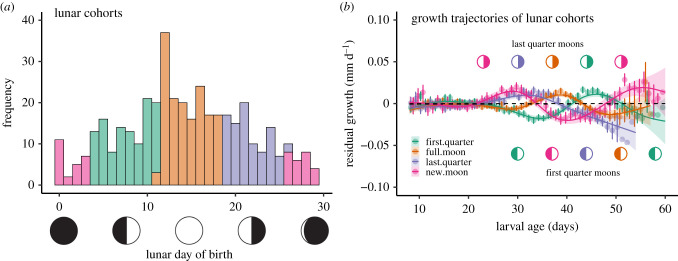Figure 1.
Lunar cohorts of larval sixbar wrasse and their residual growth trajectories. (a) Frequencies of sampled larvae (n = 411) born on each LD. Colour identifies ‘lunar cohort’ determined by birthdate on a lunar calendar (estimated from otoliths). Birthdates from LD ∼ 26 to LD 3 = ‘new moon’; 4 ≤ LD ≤ ∼11 = ‘first quarter’; approximately 12 ≤ LD ≤ 18 = ‘full moon’; 19 ≤ LD ≤ ∼25 = ‘last quarter’ (note that variation assignments at day 11 and 26 is owing to uneven durations of lunar months). (b) Residual (i.e. age-independent) growth trajectories of larvae assigned to four lunar cohorts. Given are mean ± 1 s.e. residual growth per day (points are offset for presentation) and fitted lines are predicted by a GAM (span = 3). Dashed line indicates average growth. Symbols indicate the timing of the last quarter moons (top) and first quarter moons (bottom) for each lunar cohort (i.e. for median lunar birthdates of each lunar cohort). (Online version in colour.)

